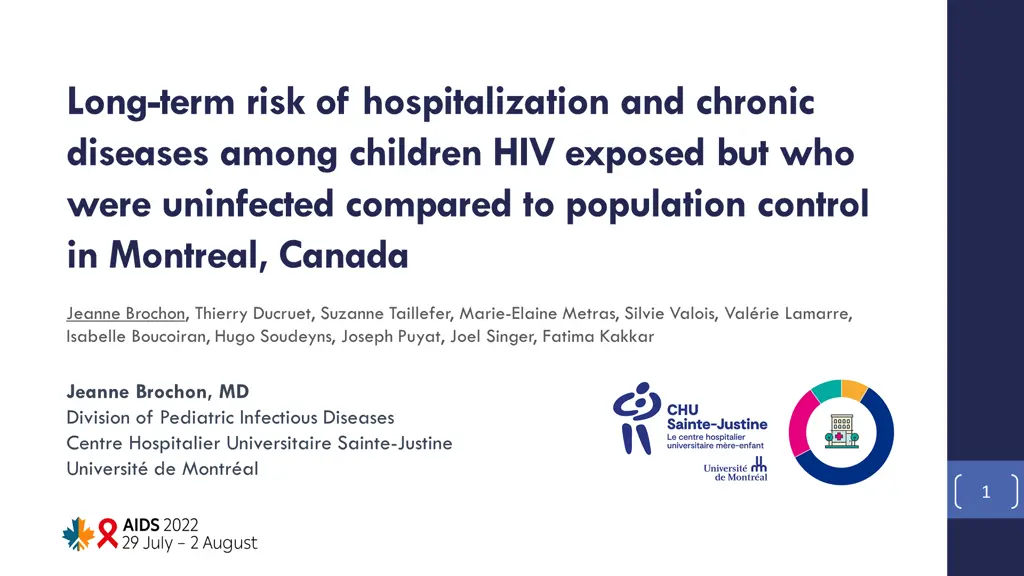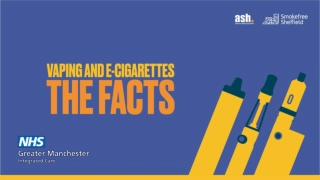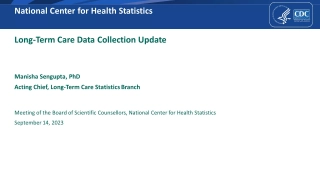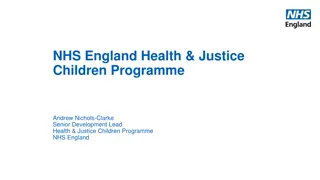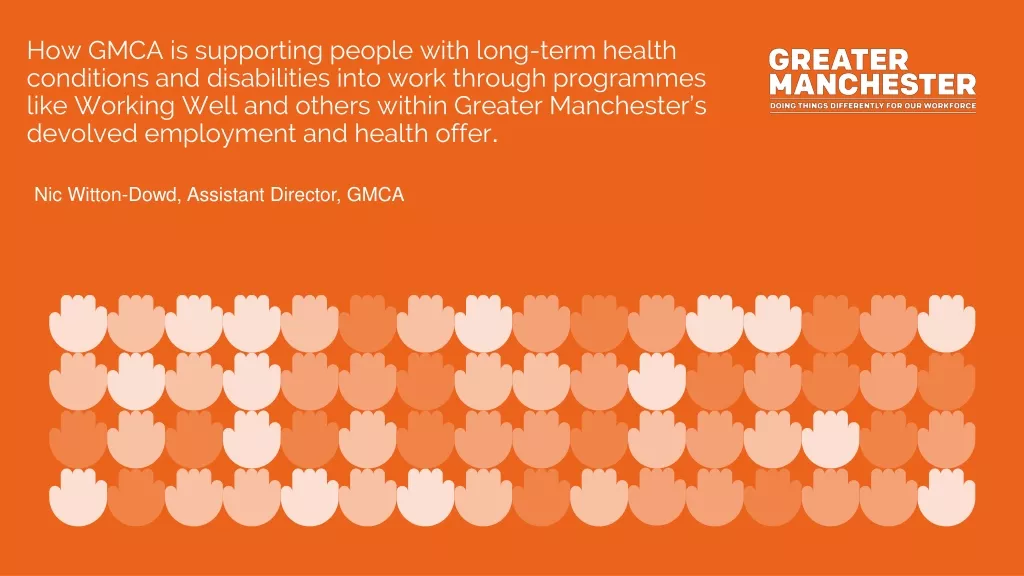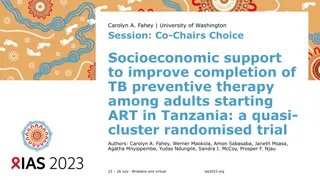Long-term Health Risks Among Children HIV-Exposed
Study comparing risks of hospitalization and chronic diseases in HIV-exposed uninfected children vs. population control in Montreal, Canada. Data indicates heightened risks in CHEU including bacterial infections, mortality, hospitalization, poor growth, psychiatric disorders, and neurological outcomes. Factors influencing risks are multifactorial. The study posits the question of outcomes in resource-rich settings with universal healthcare access.
Download Presentation
Please find below an Image/Link to download the presentation.
The content on the website is provided AS IS for your information and personal use only. It may not be sold, licensed, or shared on other websites without obtaining consent from the author. Download presentation by click this link. If you encounter any issues during the download, it is possible that the publisher has removed the file from their server.
Presentation Transcript
Long-term risk of hospitalization and chronic diseases among children HIV exposed but who were uninfected compared to population control in Montreal, Canada Jeanne Brochon, Thierry Ducruet, Suzanne Taillefer, Marie-Elaine Metras, Silvie Valois, Val rie Lamarre, Isabelle Boucoiran, Hugo Soudeyns, Joseph Puyat, Joel Singer, Fatima Kakkar Jeanne Brochon, MD Division of Pediatric Infectious Diseases Centre Hospitalier Universitaire Sainte-Justine Universit de Montr al 1
Financial disclosure Nothing to declare 2
Land acknowledgement We acknowledge that this work takes place in Tiohti :ke (Montr al), from where I speak, on the unceded lands of the Kanien keh :ka (Mohawk Nation) 3
Uninfected, but not unaffected Over the world There are an estimated 15.4 million of children HIV- exposed but who are uninfected (CHEU) globally. 1 CHEU2 Despite averting HIV infection, there are concerns about the health of CHEU. 4 1Wedderburn, Lancet, 2022 2 UNAIDS epidemiological estimates, 2021
Data from predominantly resource-limited settings Increased risk Bacterial infections3 Mortality1 Hospitalisation (all cause and ID)2 1 Brennan, AIDS, 2016 2 Anderson, AIDS, 2021 3 Taron-Brocard, CID, 2014 Poor growth and stunting 4 Psychiatric disorders6 Neurological outcomes5 5 4 Evans, Clin Infect Dis, 2021 5 Wedderburn, Lancet, 2022 6 Gadow, J Dev Behav Pediatr, 2010
Causes likely multifactorial Maternal immune suppression Increased mortality Mecanism Immunological abnormalities Increased hospitalization HIV viremia ART Drug exposure Mitochondrial dysfunction Infectious diseases Access to health care ? Neurodevelopmental disorders? Preterm delivery Socio- economic factors ? Chronic diseases? 6
Rationale In a resource-rich setting, with universal access to care, will we see these same outcomes? 7
Objectives Objectives To determine the incidence rate of hospitalization among CHEU (cases) compared to population controls who were HIV-unexposed uninfected (CHUU) To determine the risk of chronic diseases (heart disease, malformation, malignancy, neurologic and psychiatric disorders, endocrinological, and immunological diseases) among cases vs. controls 8
Methods CMIS cohort Prospective cohort established in 1988 in Montreal to follow pregnant women living with HIV and their children from birth until early childhood Methods Quebec public medical services database The R gie assurance maladie du Qu bec (RAMQ) is a universal health care system that covers all residents of the province regardless of age or income Individuals are assigned a unique lifetime single patient identifier RAMQ database includes all medical services and procedures billed, across all health care settings 9
Methods CHEU from the CMIS were matched (1:3) to a CHUU control from the RAMQ database, identified at random after matching for age, gender, and postal code (neighborhood) 1988 2016 Methods Outcomes Hospitalization: Any hospitalization in the province of Quebec registered in the RAMQ database Chronic conditions: Defined by system priori Determined by ICD-9 codes Analysis Survival analysis to compare incidence rate of all-cause hospitalization compared between CHEU and CHUU using Kaplan-Meier curves and Cox Proportional Hazards models For the outcome of any chronic condition, we will present risk-ratios (RR) and 95% confidence intervals (CI) for the first occurrence of each outcome within the two groups 10
30 25 CHEU 20 15 27.4 26.7 26.2 19.7 10 Results: CMIS cohort 5 0 Before 2000 2000-2004 Birth years 2005-2009 2010-2015 INSTI 1% None 1% Unknown 7% AZT alone 10% Unknown 5% NNRTI 6% Unboosted PI 31% NRTI alone 16% Combinations with ABC or TDF 20% AZT/3TC 59% Combinations with D4T/DDI/DDC 5% Boosted PI 39% 11 NRTI Exposure NNRTI, PI, INSTI
CHEU vs. CHUU controls Results CHEU N(%) CHUU N(%) p-value Total 726 (100) 2178 (100) NA Female sex assigned at birth 357 (49.2) 1071 (49.2) NA Gestational age <37 weeks 99 (13.7) 164 (8.5) <0.001 Follow-up time, median Q1-Q3 (years) 11.1 [6.6-15.9] 11.1 [6.7-15.8] NA 12
Results: primay outcome Risk of hospitalization over time CHEU CHUU CHEU CHUU Excluding prolonged birth hospitalization All hospitalization CHEU vs. CHUU 13 HR= 1.21 [1.06-1.40], p=0.006 aHR for gestational age: 1.14 [0.99-1.31], p=0.078 HR= 1.42 [1.26-1.61], p<0.001 aHR for gestational age: 1.23 [1.08-1.40], p=0.001
Results CHRONIC CONDITIONS DEFINED BY ICD-9 CODES 14
Neuropsychiatric conditions Results: chronic diseases RR= 1.28 [1.13-1.45], p<0.001 40 35 30 25 33.3% 20 26.1% 15 10 CHEU CHUU 15
Specific neuropsychiatric conditions Results: chronic diseases RR= 1.39 [1.10-1.76] p=0.007 14 CHEU CHUU 12 10 RR= 1.71 [1.20-2.44] p=0.003 8 RR= 2.13 [1.37-3.33] p<0.001 12.3 6 RR= 1.92 [1.14-3.21] p=0.012 8.8 RR= 2.29 [1.12-4.70] p=0.020 4 RR= 4.50 [1.27-15.90] p=0.010 6.2 4.4 3.6 2 3.2 2.1 1.8 1.7 0.2 0.8 Intellectual disabilities 0.8 0 Coordination disorder Psychoses Autism spectrum disorder Other or mixed developmental conditions Delays in development 16
Congenital anomalies Results: chronic diseases RR= 1.58 [1.09-2.30], p=0.016 6 5 4 3 5.5% 2 3.5% 1 0 17 CHEU CHUU
Specific congenital anomalies Results: chronic diseases Congenital musculoskeletal anomalies Atrial septal defect 20 10 8 15 6 10 8.4% 4 14.7% 10.8% 5 2 2.8% 0 0 CHEU CHUU CHEU CHUU RR= 3.00 [2.13-4.24], p<0.001 RR= 1.37 [1.10-1.69], p=0.004 18
Endocrine system Results: chronic diseases RR= 0.70 [0.55-0.88], p=0.002 20 18 16 14 12 10 8 15.7% 6 10.9% 4 2 19 0 CHEU CHUU
Specific endocrine conditions Results: chronic diseases Underweight, short stature & feeding difficulties Diabetes 20 20 15 15 10 10 19% 13.4% 5 9.9% 5 9.3% 0 0 CHEU CHUU CHEU CHUU 20 RR= 0.52 [0.41-0.66], p<0.001 RR= 2.43 [1.14-1.80], p=0.002
Summary of chronic conditions Results: chronic diseases CHEU (n=726) N(%) CHUU (n=2178) N(%) Incidence rate ratios RR 95%CI p-value Congenital anomalies 40 (5.5) 76 (3.5) 1.58 [1.09 - 2.3] 0.016 Neuro-psychiatric disorders 241 (33.3) 566 (26.1) 1.28 [1.13 - 1.45] <0.001 Endocrine nutritional, metabolic and immunity disorders 79 (10.9) 340 (15.7) 0.70 [0.55 - 0.88] 0.002 Respiratory diseases 161 (22.3) 559 (25.8) 0.86 [0.74 - 1.01] 0.06 Cardiovascular system diseases 21 (2.9) 75 (3.5) 0.84 [0.52 - 1.35] 0.47 21 Neoplasms 12 (1.7) 45 (2.1) 0.8 [0.43 - 1.5] 0.89
Summary Increased risk of hospitalization in CHEU vs. CHUU controls Despite controls matched for socio-economical status (neighborhood), age and gender, and adjustment for gestational age Discussion Increased risk of neuro-psychiatric diagnoses in CHEU vs. CHUU controls Significant concern given the millions of CHEU globally Confirms findings from previous cohorts1,2, and clinical reality 22 1 Piske, AIDS, 2018 2Wedderburn, Lancet, 2022
Discussion Study limitations Administrative data: ICD9 codes are non-exhaustive, reflect billing not necessarily clinical reality Imperfect matching within neighborhoods, and multiple unadjusted confounders Different ART exposure over time, including older regimens no longer used in pregnancy Discussion Strengths Linkage of clinical to administrative data allows for long-term outcomes assessment of CHEU as they move into adulthood Provides insight into potential signals that could be assessed in larger cohorts (for example: risk of diabetes) 23
CHEU: Beyond surviving to thriving? While work into understanding the causes of differences in health outcomes among CHEU and CHUU is ongoing, these data suggest that CHEU could benefit from: Enhanced access to primary care regardless of setting Early neurodevelopmental assessments and screening Ongoing care beyond time of HIV negative diagnosis Conclusion 24
Acknowledgements The CMIS clinical cohort team Silvie Valois Dr Suzanne Taillefer Dr Hugo Soudeyns Martine Caty Joanne Samson Thierry Ducruet Patricia Connolly Chantal Lapointe Diane Noel Anne Marie Vermette Dr Normand Lapointe Dr Marc Boucher Dr Valerie Lamarre Dr Chris Karatzios Dr Christian Renaud Dr Isabelle Boucoiran Dr Fatima Kakkar Dr Soren Gantt Nathalie Pichette Marie Elaine Metras Pascal Bedard 25
